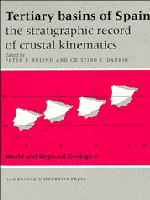Book contents
- Frontmatter
- Contents
- List of contributors
- Preface
- Dedication to Professor Oriol Riba IArderiu
- Memorial, Etienne Moissenet 1941–1994
- PART G GENERAL
- PART E EAST
- PART W WEST
- PART C CENTRE
- PART S SOUTH
- S1 The Betic Neogene basins: introduction
- S2 Neogene palaeogeography of the Betic Cordillera: an attempt at reconstruction
- S3 Depositional model of the Guadalquivir – Gulf of Cadiz Tertiary basin
- S4 Late Neogene depositional sequences in the foreland basin of Guadalquivir (SW Spain)
- S5 Miocene basins of the eastern Prebetic Zone: some tectono sedimentary aspects
- S6 Stratigraphic architecture of the Neogene basins in the central sector of the Betic Cordillera (Spain): tectonic control and base-level changes
- S7 Pliocene–Pleistocene continental infilling of the Granada and Guadix basins (Betic Cordillera, Spain): the influence of allocyclic and autocyclic processes on the resultant stratigraphic organization
- S8 Late Neogene basins evolving in the Eastern Betic transcurrent fault zone: an illustrated review
- S9 Tectonic signals in the Messinian stratigraphy of the Sorbas basin (Almeria, SE Spaín)
- S10 Basinwide interpretation of seismic data in the Alborán Sea
- Index
S8 - Late Neogene basins evolving in the Eastern Betic transcurrent fault zone: an illustrated review
Published online by Cambridge University Press: 04 August 2010
- Frontmatter
- Contents
- List of contributors
- Preface
- Dedication to Professor Oriol Riba IArderiu
- Memorial, Etienne Moissenet 1941–1994
- PART G GENERAL
- PART E EAST
- PART W WEST
- PART C CENTRE
- PART S SOUTH
- S1 The Betic Neogene basins: introduction
- S2 Neogene palaeogeography of the Betic Cordillera: an attempt at reconstruction
- S3 Depositional model of the Guadalquivir – Gulf of Cadiz Tertiary basin
- S4 Late Neogene depositional sequences in the foreland basin of Guadalquivir (SW Spain)
- S5 Miocene basins of the eastern Prebetic Zone: some tectono sedimentary aspects
- S6 Stratigraphic architecture of the Neogene basins in the central sector of the Betic Cordillera (Spain): tectonic control and base-level changes
- S7 Pliocene–Pleistocene continental infilling of the Granada and Guadix basins (Betic Cordillera, Spain): the influence of allocyclic and autocyclic processes on the resultant stratigraphic organization
- S8 Late Neogene basins evolving in the Eastern Betic transcurrent fault zone: an illustrated review
- S9 Tectonic signals in the Messinian stratigraphy of the Sorbas basin (Almeria, SE Spaín)
- S10 Basinwide interpretation of seismic data in the Alborán Sea
- Index
Summary
Abstract
Late Neogene sedimentary basins evolved within a wide transcurrent shear zone which passes through the Eastern Betic zone from the NE to the SW, and constitutes a segment of the major trans-Alboran shear zone. During the whole Neogene this structural corridor was subjected to a near-North–South compression resulting from the Iberia–Africa collision. As usual in wrench tectonics, compressional and extensional areas evolved at the same time within the structural corridor and controlled the development of two types of basin: groove-shaped faulted synclines and grabens. During the past ten million years, the direction of regional shortening varied between NW–SE and N–S, with important consequences for the kinematics of faulting and the sedimentary processes. Diversified magmatic activity, concentrated within the shear zone, interfered with the tectonic and sedimentary processes, especially during Tortonian times. The different magmatic products, originating from crustal (anatexis) and mantle lineages were telescoped within the corridor (e.g. Cabo de Gata), without any geochemical polarity indicative of a Miocene subduction zone. The major NE–SW trend of faults is deeply rooted in the lithosphere and marks the boundary between two different crustal slabs. The eastern slab is thinner and denser and has recorded an important late Miocene thermal anomaly. The basin evolution was greatly influenced by the properties of this hot and thin crust, which was particularly malleable under tectonic stress.
- Type
- Chapter
- Information
- Tertiary Basins of SpainThe Stratigraphic Record of Crustal Kinematics, pp. 372 - 386Publisher: Cambridge University PressPrint publication year: 1996
- 8
- Cited by



